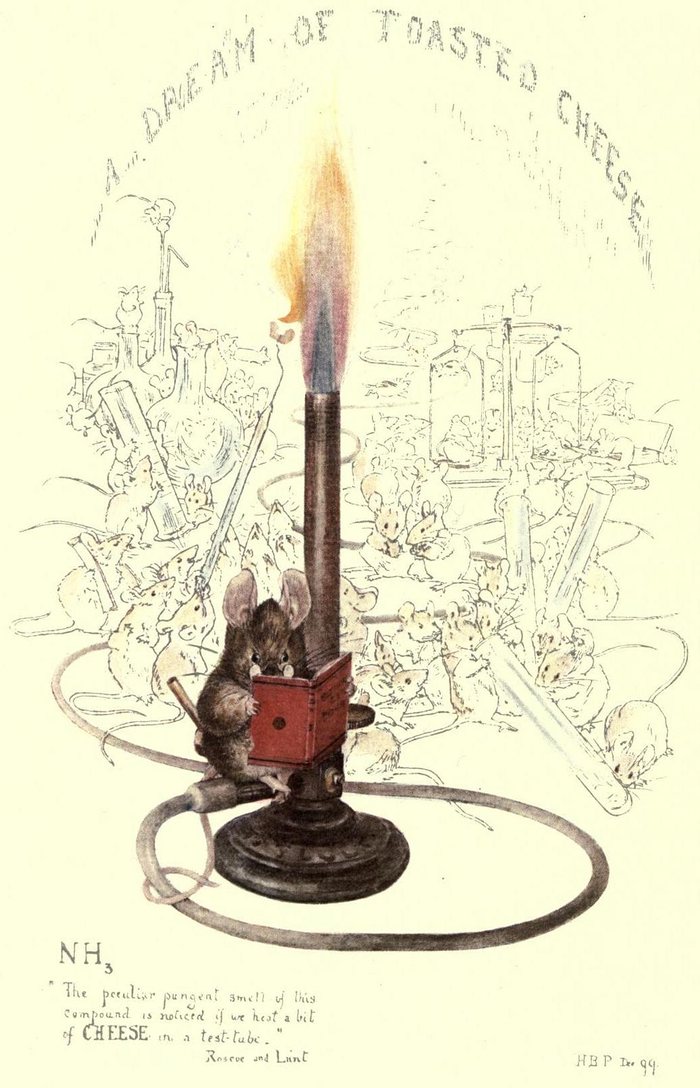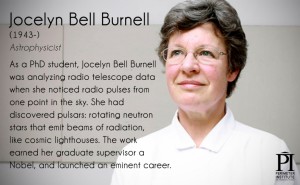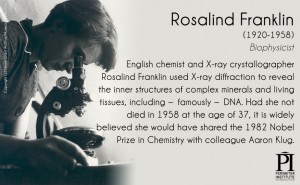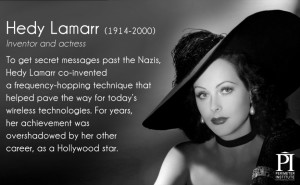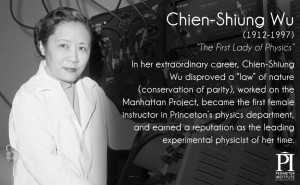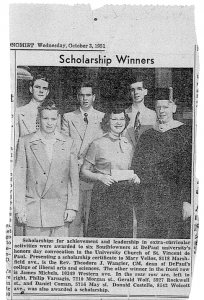I was thinking we’d get a few more months before another ‘how women are treated in science circles’ or gender issues (as it is sometimes known) story erupted. Our last cycle was featured in my Oct. 18, 2013 posting and mentioned again in my Dec. 31, 2013 posting titled: 2013: women, science, gender, and sex. (Note: I will be referring to these postinsg and the Oct. scandals again in this posting but first, I have to lay the groundwork.)
It seems Henry Gee, a senior editor at Nature magazine, disagreed with my preference for waiting a few more months and decided to start a new cycle on Jan. 17, 2014 when he outed (revealed her personal name) pseudonymous blogger and online presence, Dr. Isis, on his Twitter feed. Here’s the nature (pun noted) of the offence (from Michael Eisen’s Jan. 20, 2014 posting on his ‘it is NOT junk’ blog),
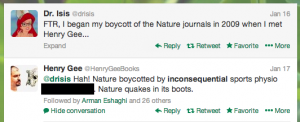 In addition to Dr. Isis’ personal name, Gee describes her as an “inconsequential sports physio” which seems to have disturbed some folks at least as much as the outing. Dr. Isis describes herself this way (from the Isis the Scientist blog About page,
In addition to Dr. Isis’ personal name, Gee describes her as an “inconsequential sports physio” which seems to have disturbed some folks at least as much as the outing. Dr. Isis describes herself this way (from the Isis the Scientist blog About page,
Dr. Isis is an exercise physiologist at a major research university working on some terribly impressive stuff. …
In the Jan. 20, 2014 posting on her blog, Dr. Isis responds to Gee’s action on Twitter (partial excerpt from the posting; Note: Links have been removed),
So, while I am “ok”, were his actions “ok?” Of course not, and they give me pause. I have undoubtedly been vocal over the last four years of the fact that I believe Nature, the flagship of our profession, does not have a strong track record of treating women fairly. I believe that Henry Gee, a representative of the journal, is responsible for some of that culture. That’s not “vitriolic” and it’s not “bullying”. That is me saying, as a woman, that there is something wrong with how this journal and its editors engage 50% of the population (or 20% of scientists) and I believe in my right to say “this is not ‘ok’.” Henry Gee responded by skywriting my real name because he believed that would hurt me personally – my career, my safety, my family. Whatever. Regardless of the actual outcome, the direct personal nature of the attack is highlighted by its support from some that I “had it coming.. [emphasis mine]
…
Henry Gee’s actions were meant to intimidate me into silence. He took this approach likely with the thought that it was the most powerful way he could hurt me. Nothing more. Although I am ok, there are some recent victims of outing behavior that are not. That’s frightening. To think that the editor of a journal would respond to criticism of his professional conduct regarding the fair treatment of women by attempting to personally injure and damage..
I recommend reading the post in it’s entirety as she also addresses the adjective, ‘inconsequential’ and expands further on the issues she has with Nature (magazine). As for the emphasis I”ve added to the phrase “… I have it coming …”, it reminded me of this passage in my Dec. 31, 2013 posting,
think we (men and women) are obliged to take good look at sexism around us and within us and if you still have any doubts about the prevalence of sexism and gender bias against women, take a look at Sydney Brownstone’s Oct. 22, 2013 article for Fast Company,
These ads for U.N. Women show what happens if you type things like “women need to” into Google. The autocomplete function will suggest ways to fill in the blank based on common search terms such as “know their place” and “shut up.”
…
A quick, unscientific study of men-based searches comes up with very different Autocomplete suggestions. Type in “men need to,” and you’ll get “feel needed,” “grow up,” or “ejaculate.” Type in “men shouldn’t,” and you might get, “wear flip flops.”
Those searches were made in March 2013.
Gee managed to fuse two prevailing attitudes toward women in a single tweet, rage when women aren’t ‘nice’ or ‘don’t know their place’ (apparently, Dr. Isis can be quite stinging in her criticisms and so he outs her) and dismissiveness (she’s an “inconsequential sports physio”) while showcasing Nature’s (his employer) and by extension his own importance in the world of science (“Nature quakes in its boots”).
Michael Eisen in his Jan. 20, 2014 posting explains why he thinks this situation is important and unpacks some of the reasons why a young scientist might wish to operate with a pseudonym (Note: A link has been removed),
Gee and Dr. Isis have apparently had issues in the past. I don’t know the full history, but I was witness to some of it after Gee published a misogynistic short story in Nature several years back. Gee behaved like an asshole back then, and apparently he has not stopped.
Think about what happened here. A senior figure at arguably the most important journal in science took it upon himself to reveal the name of a young, female, Latina scientist with whom he has fought and whom he clearly does not like. …
…
Having myself come under fairly withering criticism from Dr. Isis, I feel somewhat qualified to speak to this. She has a sharp tongue. She speaks with righteous indignation. I don’t always think she’s being fair. And, to be honest, her words hurt. But you know what? She was also right. I have learned a lot from my interactions with Dr. Isis – albeit sometimes painfully. I reflected on what she had to say – and why she was saying it. I am a better person for it. I have to admit that her confrontational style is effective.
…
If our conflicts had existed in the “real world” where I’m a reasonably well known, male tenured UC [University of California] Berkeley professor and HHMI [Howard Hughes Medical Institute] Investigator and she’s a young, female, Latina woman at the beginning of her research career, the deck is stacked against her. Whatever the forum, odds are I’m going to come out ahead, not because I’m right, but because that’s just the way this world works. And I think we can all agree that this is a very bad thing. This kind of power imbalance is toxic and distorting. It infuses every interaction. The worst part of it is obvious – it serves to keep people who start down, down. But it also gives people on the other side the false sense that they are right. It prevents them from learning and growing.
But when my interlocutor is anonymous, the balance of power shifts. Not completely. But it does shift. And it was enough, I think, to fundamentally change the way the conversations ended. And that was a good thing. I know I’m not going to convince many people that they should embrace this feeling of discomfort – this loss of power. But I hope, at least, people can appreciate why some amongst us feel so strongly about protecting this tool in their arsenal, and why what Gee did is more fundamental and reprehensible than the settling of a grudge.
I recommend reading Eisen’s posting in its entirety and this Jan. 21, 2014 posting by Dr. Julienne Rutherford on her Biological ANthropology Developing Investigators Troop blog. She provides more context for this situation and a personal perspective as an untenured professor herself (Note: Links have been removed),
As a biological anthropologist working toward tenure, a paper in Nature could “make” my career. I have as-yet-untenured colleagues at Ivies who get tsked-tsked for NOT submitting to Nature. The reverence for impact factors requires us to consider this the pinnacle of scientific publishing, at the same time that senior representatives of that very same journal with public platforms show absolutely no shame in trivializing our efforts as scientists or our very real struggles as outsiders in the Old White Boys Club. Struggles that make me feel like this a lot, and I actually have it pretty easy.
This continued outsider existence is what leads many to seek the clearly imperfect protection of an online pseudonym. Pseudonymity on the the internet has a long and defensible history, largely as protection of some kind, often against reprisals by employers. Sometimes as protection against cyber-stalking and sometimes real-life stalking and physical assault. But another reason is that it can offer protection against the clubbishness and bullying of privileged scholars with powers to hire, publish, grant funds. The power to deem one as a scientist of consequence. The power to refuse the pervasive poison that is their privilege and blindness. …
Interestingly, the same day Gee lashed out at Dr. Isis, Nature issued an apology for a letter they had recently published. Here’s an excerpt from the letter that was published online on Jan. 15, 2014,
Research: Publish on the basis of quality, not gender by Lukas Koube. Nature 505, 291 (16 January 2014) doi:10.1038/505291e Published online 15 January 2014
The publication of research papers should be based on quality and merit, so the gender balance of authors is not relevant in the same way as it might be for commissioned writers (see Nature 504, 188; 2013) [a special issue on women and gender issues in science]. Neither is the disproportionate number of male reviewers evidence of gender bias. …
Koube’s letter is behind a paywall but i gather the rest of it continues in a similarly incendiary and uninformed fashion.
Kelly Hills writes about the letter and Nature’s apology in a Jan. 17, 2014 posting on her Life As An Extreme Sport blog (Note: Links have been removed),
…
While Nature’s apology is better than a nonpology, it’s not actually a full apology, and it doesn’t surprise me that it’s not being as well-received as the editors likely hoped. I detailed some of my issues with the apology on Twitter this morning, but I wanted to take the time to actually expand on what is necessary for a complete apology.
You can find quite a few different opinions on what constitutes an actual apology. I am fond of a four stage approach: Recognition, Responsibility, Remorse/Regret, Remedy. I think it’d be easiest to go through each of these and the Nature apology, to see where they succeed, and where they fail. Hopefully this will be illustrative not only to them now, but others in the future.
…
… When you recognize your mistake, you need to be specific. This is what Nature said:
On re-examining the letter and the process, we consider that it adds no value to the discussion and unnecessarily inflames it, that it did not receive adequate editorial attention, and that we should not have published it.
This isn’t a bad start. Ultimately, there is recognition that the commentary was inflammatory and it shouldn’t have been published. That said, what would have made it a good example of recognition is acknowledgement that the commentary that was published was offensive, as well. It’s not about adding no value, or even being inflammatory–it’s that it’s a point of view that has been systematically deconstructed and debunked over years, to the point that people who hold it are actually advocating biased, if not complete misogynistic, positions.
I found this a very interesting read as Hills elucidates on one of my pet peeves, the non apology apology and something I recognize as one of my own faults, offering a non apology, i.e., offering excuses for my behaviour along with “I’m sorry.”
Before finishing this post, I want to include a little more information about Henry Gee (from his Wikipedia essay; Note: Links have been removed),
Dr Henry Gee (born 1962 in London, England) is a British paleontologist and evolutionary biologist. He is a senior editor of Nature, the scientific journal.[1]
Gee earnt his B.Sc. at the University of Leeds and completed his Ph.D. at Fitzwilliam College, Cambridge, where, in his spare time, he played keyboard for a jazz band fronted by Sonita Alleyne, who went on to establish the TV and radio production company Somethin’ Else.[2] Gee joined Nature as a reporter in 1987 and is now Senior Editor, Biological Sciences.[citation needed] He has published a number of books, including Before the Backbone: Views on the Origin of the Vertebrates (1996), In Search of Deep Time (1999),[3][4] A Field Guide to Dinosaurs (illustrated by Luis Rey) (2003) and Jacob’s Ladder (2004).
…
On January 17th, 2014, Gee became embroiled in internet controversy by revealing the identity of an anonymous science blogger, Melissa Bates [7]. Bates was an open critic of the scientific journal Nature, where Gee is a senior editor. Gee’s comments were an apparent attempt to discredit the blogger’s reputation, but many felt his doxing went too far[8] . It was later revealed that Gee is not unfamiliar with pseudonyms himself, using the pseudonym “Cromercrox” to curate his own Wikipedia entry.
I am a bit surprised by the lack of coverage on the Guardian science blogs where a number of essays were featured during the Oct. 2013 ‘sex scandals’. Perhaps no one has had enough time to write it up or perhaps the Guardian editors feel that enough has been written about gender and science. Note, Henry Gee writes for the Guardian.
It’s hard for me to tell whether or not Henry Gee’s Twitter feed (@HenryGeeBooks) is a personal account or a business account (access seems to be restricted as of Jan. 22, 2014 12:40 pm PDT; you can access this) but it does seem that Gee has conflated his professional and personal lives in such a way that one may not be easily distinguishable from the other. This does leave me with a question, is Nature responsible for comments made on their employee’s personal Twitter feed (assuming HenryGeeBooks is a personal feed)? No and yes.
As far as I’m concerned no employer has a right to control any aspects of an employee’s personal life unless it impacts their work, e.g. pedophiles should not be employed to work with young children. In Henry Gee’s case he invoked his employer and his professional authority as one of their editors with “Nature quakes in its boots” and that means I expect to see some sort of response from NPG .
I’ve mentioned the October 2013 scandals because Nature Publishing Group (NGP) owns Scientific American, one of the publications that was at the centre of the scandals. Their (Scientific American/NPG) response was found to be lacking that time too. At this point, we have two responses that are lacking (the excuses over the Scientific American aspects of the October 2013 scandals and the apology over the Koube letter published in January 2014) and a nonresponse with regard to Gee’s tweet.
Regarding Henry Gee, perhaps this massive indignation which has caused his Twitter page to be made inaccessible, at this time will also cause him to reconsider his attitudes about women and about the power he wields (or wielded?). I fear that won’t be the case and that he’s more likely to be building resentment. Ultimately, this is what confounds me about these situations, how does one confront a bully without driving them into more extreme forms of the behaviour and attitudes that led to the confrontation? I don’t believe there’s ‘a one size fits all’ answer to this, I just wish there was more discussion about the issue. I speak here as a Canadian who is still haunted by L’École Polytechnique massacre in Montréal (from the Wikipedia essay; Note: Links have been removed),
The École Polytechnique Massacre, also known as the Montreal Massacre, occurred on December 6, 1989 at the École Polytechnique in Montreal, Quebec, Canada. Twenty-five-year-old Marc Lépine, armed with a legally obtained Mini-14 rifle and a hunting knife, shot twenty-eight people before killing himself. He began his attack by entering a classroom at the university, where he separated the male and female students. After claiming that he was “fighting feminism” and calling the women “a bunch of feminists,” he shot all nine women in the room, killing six. He then moved through corridors, the cafeteria, and another classroom, specifically targeting women to shoot. Overall, he killed fourteen women and injured ten other women and four men in just under twenty minutes before turning the gun on himself.[1][2]
I applaud the women who have spoken up and continue to speak up and I hope we all men and women can work towards ways of confronting bullies while also allowing for the possibility of change.
Finally, thanks to Susan Baxter for alerting me to this latest gender and science story cycle. Here’s Susan’s blog where she writes about medical matters (mostly). Her latest post concern’s Lyme’s disease.
